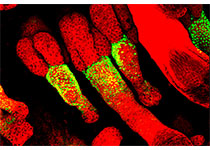Recently, Yuxing, Chen and Congzhao, Zhou, professors of National Research Center for Microscale Material Science and Department of Life Science and Medicine of University of Science and Technology of China, collaborated with Linfeng Sun’s group to analyze the near-atomic resolution 3D structure of human lysosomal vitamin B12 efflux protein ABCD4 using cryo-EM technology for the first time, providing a basis for in-depth understanding of the molecular mechanism of this type of membrane protein transport and the pathogenic mechanism of its mutation-induced diseases. The study was published online in Cell Research under the title Cryo-EM structure of human lysosomal cobalamin export ABCD4.
Vitamin B12 can be synthesized only in a few bacteria and archaea in nature, and as an essential nutrient for humans, it can only be ingested from food. Vitamin B12 enters the cell via receptor-mediated endocytosis and is subsequently stored in lysosomes in a free form and is utilized for efflux to the cytoplasm when needed. Studies have shown that the human ATP-binding cassette (ABC) transporter ABCD4 is localized on lysosomal membranes and may play a key role in the efflux of vitamin B12 into the cytoplasm within lysosomes. Mutations in the ABCD4 gene may lead to a spectrum of congenital vitamin B12 deficiencies. Its symptoms include hypotonia, bone marrow depression, macrocytic anemia, and heart disease. However, the molecular mechanism of vitamin B12 efflux in lysosomes is unclear, which restricts the understanding and treatment of related diseases.

ABC membrane transporters are widely distributed in prokaryotes and eukaryotes as a class of multi-spanning membrane proteins that achieve transmembrane transport of substances by binding and hydrolyzing ATP to obtain energy. Its transport substrates include ions, amino acids, short peptides, sugars, and lipids, which participate in a variety of important physiological functions and are closely related to drug resistance of tumor cells. In recent years, due to the rapid development of single-particle cryo-EM technology, the molecular structures of a series of human ABC membrane transporters have been elucidated, covering all subfamilies except the ABCD subfamily. The structure of Abcd4 reported here fills this gap as the first three-dimensional structure of subfamily D. The authors successfully expressed and purified the human ABCD4 protein in good condition after extensive exploration, and solved the high-resolution three-dimensional structure of the protein in its bound state to ATP (adenosine triphosphate) to 3.6 Å resolution (0.36 nm) using single-particle cryo-EM. The protein consists of 606 amino acid residues and functions in the human body as a homodimer. The structure solved this time is that of the ABCD4 dimeric complex in the physiological state, containing two six-transmembrane transmembrane domains (TMDs) and two nucleic acid binding domains (NBDs), which globally assume a conformation open to within the lysosome, in which the two nucleic acid binding domains each bind an ATP molecule and dimerize, and the two transmembrane domains open towards the lysosomal matrix by interleaving of the transmembrane helices to form two “wings”.
Based on the protein backbone and side-chain spatial information provided by the structure, the authors analyzed the pathogenic mechanism of the mutants of the protein in clinical practice. The authors found that mutations in clinical samples can disrupt interactions within the protein molecule (introduction of disulfide bonds) or between ATP molecules (salt bridges), or cause the protein to misfold, ultimately resulting in the inability of the protein to normally catalyze ATP hydrolysis or undergo conformational changes, leading to associated diseases. The authors, in turn, constructed these mutant versions of the protein on liposomes to further validate the predictions of the structural analysis using biochemical activity. At the same time, based on the structure, they proposed the transport mechanism of ABCD4. Due to its localization on lysosomal membranes, ABCD4 employs an antiport mechanism distinct from the classical ABC efflux proteins to efflux vitamin B12.